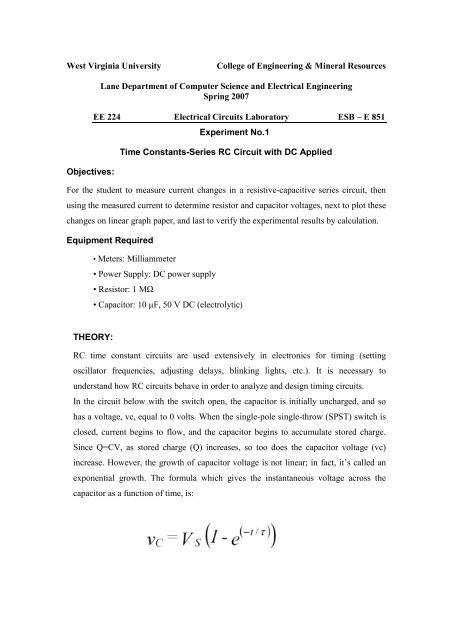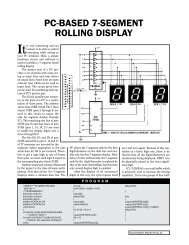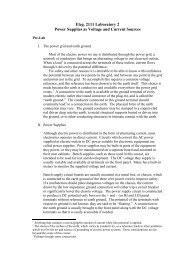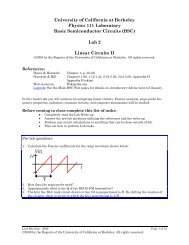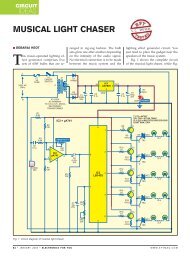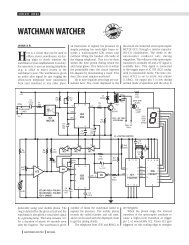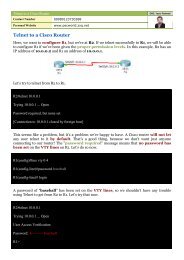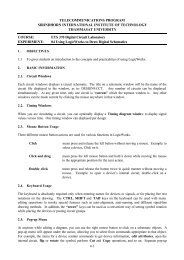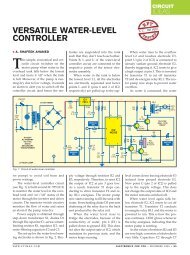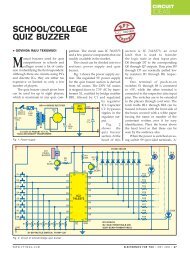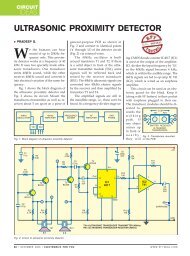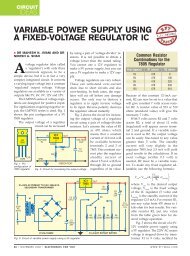Time Constant- Series RC Circuit with DC Applied
Time Constant- Series RC Circuit with DC Applied
Time Constant- Series RC Circuit with DC Applied
Create successful ePaper yourself
Turn your PDF publications into a flip-book with our unique Google optimized e-Paper software.
West Virginia University<br />
College of Engineering & Mineral Resources<br />
Objectives:<br />
Lane Department of Computer Science and Electrical Engineering<br />
Spring 2007<br />
EE 224 Electrical <strong>Circuit</strong>s Laboratory ESB – E 851<br />
Experiment No.1<br />
<strong>Time</strong> <strong>Constant</strong>s-<strong>Series</strong> <strong>RC</strong> <strong>Circuit</strong> <strong>with</strong> <strong>DC</strong> <strong>Applied</strong><br />
For the student to measure current changes in a resistive-capacitive series circuit, then<br />
using the measured current to determine resistor and capacitor voltages, next to plot these<br />
changes on linear graph paper, and last to verify the experimental results by calculation.<br />
Equipment Required<br />
• Meters: Milliammeter<br />
• Power Supply: <strong>DC</strong> power supply<br />
• Resistor: 1 MΩ<br />
• Capacitor: 10 µF, 50 V <strong>DC</strong> (electrolytic)<br />
THEORY:<br />
<strong>RC</strong> time constant circuits are used extensively in electronics for timing (setting<br />
oscillator frequencies, adjusting delays, blinking lights, etc.). It is necessary to<br />
understand how <strong>RC</strong> circuits behave in order to analyze and design timing circuits.<br />
In the circuit below <strong>with</strong> the switch open, the capacitor is initially uncharged, and so<br />
has a voltage, vc, equal to 0 volts. When the single-pole single-throw (SPST) switch is<br />
closed, current begins to flow, and the capacitor begins to accumulate stored charge.<br />
Since Q=CV, as stored charge (Q) increases, so too does the capacitor voltage (vc)<br />
increase. However, the growth of capacitor voltage is not linear; in fact, it’s called an<br />
exponential growth. The formula which gives the instantaneous voltage across the<br />
capacitor as a function of time, is:
This formula describes exponential growth, in which the capacitor voltage is initially 0<br />
volts, and grows to a value of V S<br />
after enough time has gone by. It is important to<br />
understand each term in this formula in order to be able to use it as a tool.<br />
The use of the above formula in any <strong>RC</strong> circuit is only possible if the symbols in the<br />
equation are fully understood. The following definitions describe each of these<br />
symbols:<br />
V S<br />
= The maximum possible voltage change that will occur in the circuit during a time<br />
lapse of five time constants. For the voltage versus time graph shown below, V S<br />
is 100<br />
volts..<br />
t = The elapsed time in seconds that the circuit voltages and currents have been<br />
changing. For the voltage versus time graph shown below, t is in seconds.<br />
τ = The time constant of the circuit, and the symbol is the lower-case Greek letter<br />
TAU. τ is the product of R and C (τ = <strong>RC</strong>) in ohms and farads, and the unit of τ is<br />
seconds. R is the total resistance in series <strong>with</strong> the capacitor, and C is the total<br />
capacitance of the circuit.<br />
v C<br />
= The capacitor voltage at any instant of time after the switch closes.<br />
e = The base of natural logarithms, a constant which equals about 2.7183.<br />
Figure 1 below is a graph of the capacitor voltage in a circuit where the time constant,<br />
τ, is 1.0 second, and V S<br />
is 100 volts. Notice that after about 5 seconds (i.e. 5 τ) the<br />
capacitor voltage has grown from 0 volts to 100 volts, and the capacitor voltage is 100<br />
volts and appears to have stopped changing. This is a condition called “steady-state”.<br />
While in theory it takes an infinite time for “steady-state” conditions to be reached, in<br />
practical terms, after five time constants using practical lab instruments it is nearly<br />
impossible to measure any changes occurring.
Graph of capacitor voltage (vc) versus time<br />
Procedure:<br />
1. Construct the circuit shown below. Let R = 1 MΩ, 0.25 W, C = 10 µF (50 V<br />
electrolytic), V S<br />
= 20 V <strong>DC</strong>, and use an alligator lead jumper as the short circuit across<br />
the capacitor.<br />
2. Record the initial current reading of the milliammeter; it should be closed to “fullscale”<br />
for a digital meter on the µA range (I = 20 V/1MΩ). Express the current in units<br />
of µA.<br />
Initial current = ____________µA<br />
Write the above initial current value in the table on page 6, in the row for t = 0.0<br />
seconds, for both Trial One and Trial Two.<br />
3. Since it takes five times constants for a capacitor to fully charge, calculate one time<br />
constant and five time constants for this circuit; if necessary, change your data table to<br />
ensure that data is taken for no less than five time constants.
<strong>RC</strong> = 1τ<br />
5(<strong>RC</strong>) = 5τ<br />
Now get ready for some serious sustained data taking! This is best done <strong>with</strong> a partner,<br />
but can be done successfully by one person. You will need a watch, (preferably a<br />
stopwatch), or an analog wall clock <strong>with</strong> a second hand. The instant you remove the<br />
alligator jumper, the current (which had been flowing through the jumper) flows<br />
through the capacitor. This is time = 0, and you will begin recording data every 5<br />
seconds after that instant.<br />
4. Every 5 seconds, record the current under the Trial One column, until that column is<br />
filled, on the data table on page 5 of this experiment.<br />
5. Now repeat steps 3 and 4, because obtaining accurate, repeatable readings when the<br />
current is changing is difficult. The results of Trial One and Trial Two will then be<br />
averaged. Be sure to replace the alligator jumper before starting Trial Two. There<br />
will be a significant spark the moment you put the jumper across the capacitor,<br />
resulting from the rapid discharge of the energy stored in the capacitor, which brings its<br />
voltage back to 0 volts.<br />
6. Average the currents (Trial One and Trial Two) for each row in the data table, and<br />
enter that average current in the table.<br />
7. At each time in the table, using the average current at that time, calculate the resistor<br />
voltage, using V R<br />
= I(R); this is Ohm’s Law. Be sure to used the measured value of R.<br />
8. Now, for each time in the table, using the calculated resistor voltage, calculate the<br />
capacitor voltage using V C<br />
= (V S<br />
- V R<br />
). Be sure to used the measured value of R. This is<br />
just Kirchhoff’s Voltage Law applied: the sum of the resistor voltage and the capacitor<br />
voltage must equal the source voltage.<br />
9. It’s plotting time! Now you are going to construct a single graph, <strong>with</strong> two curves<br />
(dependent variables) on it. You will plot v R<br />
vs. time, and v C<br />
vs. time. In setting up the<br />
axes of your graph, note that the time axis should be in seconds. Also, realize that:<br />
• The resistor voltage starts at V S<br />
and exponentially decays to nearly 0 volts.<br />
• The capacitor voltage starts at 0 volts and exponentially grows to nearly V S<br />
volts.
When your graph is done, it should look something like the following graph made <strong>with</strong><br />
Micosoft Excel.<br />
Notice that Vc starts at 0 volts, and rises exponentially to 30 volts (the supply voltage). Vr<br />
begins at 30 volts, and exponentially decays to 0 volts.
TIME<br />
CURRENT<br />
TRIAL 1 TRIAL 2 AVERAGE<br />
RESISTOR<br />
VOLTAGE<br />
Vr<br />
CAPACITOR<br />
VOLATGE<br />
Vc


